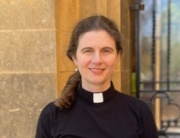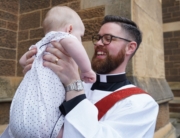A sermon given at the 8am BCP Eucharist and 10.30am Sung Eucharist on Sunday 24 July, by The Rev’d Sally Sanford-Morgan.
Sermon Luke 11:1-13 July 24
May the words of my mouth and the meditation of our hearts be acceptable to you, O Lord, our rock and our redeemer, Amen
One of the many game shows that have been on TV in the last few years is Family Feud. In this game family teams need to guess what the most common answers might be to simple questions. Common questions might be something like name something you would find in a fridge, or What would you take on an overnight trip, or maybe even name a song from the 1970s? It is always interesting to hear what the most common answers are and given today’s Gospel reading, I can’t help but think that if there was a question that asked contestants to name a famous prayer that a very high number of answers would be The Lord’s Prayer. It is the greatest prayer of the Christian Church and has been translated into almost every language in the world and because it is so well known it has some unusual uses. One of these is that it has been used to compare languages. Collections of different translations of the prayer were studied from as early as the sixteenth century and provided information about words and their usage in many languages.
The Lord’s Prayer has been set to many and varied pieces of music and some of you might remember Sister Janet Mead, a Catholic nun from Adelaide who only died in January this year. She recorded a pop-rock version of The Lord’s Prayer in 1974. Her single reached number 3 in the Australian Singles Chart, selling more than one and a half million copies and resulted in her being nominated for a Grammy Award.
The Lord’s Prayer is even alleged to having been used to help with cooking times, before clocks were readily available for ordinary people to own, with instructions something like “let the broth simmer for three Lord’s prayers” appearing in old recipes.[1] Now, I timed how long it takes to say the Lord’s Prayer, and it took about 30 seconds, so if you are boiling an egg (and like the yolk runny), say 6 Lord’s Prayers, BUT, if you are cooking a roast I suggest you use another method of timing!!
As we heard in today’s Gospel reading, Luke has given us his version of the Lord’s Prayer. It also features in the Gospel of Matthew but has some variations in the wording. It has been the subject of much study over the centuries, being written about by many notable Christian thinkers including Origen, Gregory of Nyssa, Tertullian, Augustine, and Luther; and former Archbishop of Canterbury, Rowan Williams, highlights its importance, saying, “A great deal of the very earliest Christian reflection on prayer after the New Testament period is based firmly on the Lord’s Prayer.”[2]
Two thousand years ago it was an accepted custom that notable people taught their disciples to pray. The disciples had observed Jesus praying on several occasions and knew that it was an important part of his life, so it wasn’t an outrageous or unexpected request when they asked Jesus to teach them how to pray. The prayer that he gave them contains five important parts, and each part has its origins in the Jewish Scriptures that Jesus had grown up with. The first two of these are centred on God’s name and God’s kingdom, and the last three focus on human needs; that is our daily bread, our sins and the temptations in the world around us.
Let’s have a closer look at each of these parts.
The Gospel of Luke was written in Greek, but this is not the language that Jesus spoke. He spoke Aramaic and it is widely accepted that the word Jesus would have used to begin his prayer was Abba, an Aramaic word which is similar to our use of the word Dad or when a child says Daddy, but it has a reverent and respectful dimension combined with it. It’s an indication of a loving and close relationship between a parent and a child and is different to the way that the word Father was used for God in the Old Testament. When Jesus began his prayer with Abba, he was confirming a new type of connection to God, that involved love and trust on a personal level, and this was a new concept for those he was teaching at the time whose knowledge of God was based on the Jewish scriptures.
Having established this new type of relationship between humankind and God, Jesus then went on to add that our Father God’s name is to be hallowed. He was declaring that God’s name should be considered and treated as holy. This meant giving it a unique reverence and characteristic which includes us honouring and respecting God’s name. In Jewish culture someone’s name told you something about the characteristics of that person, so stating that God’s name was to be kept holy meant a great deal to the disciples. It also means a lot for us and reinforces the third commandment which tells us not to misuse the name of God when we speak.
When we pray your kingdom come, we are not only looking forward to a time in the future when God’s kingdom comes once and for all and everything is wonderful, amazing, and perfect; but is also relevant to now. When Jesus came to live amongst humankind, he established the kingdom of God on earth by making it possible for us to enter into a new relationship with God. As our part in this relationship, we must strive to do God’s will; praying that we can live and work to bring glory and honour to his name, and enabling God’s light to shine in our world, illuminating the kingdom of God here on earth.
Once we have prayed for God’s name and kingdom, we move to those parts of the Lord’s Prayer that concern our needs. Our initial need is for our daily bread, which means a whole lot more than simply bread. Firstly, it encompasses all of the things we need to survive, our food, water, shelter etc. for today or the following day, week or year. We are encouraged to look to God to provide us with all the necessities of life, not just the simple ones, because God is like loving parents who care very much for their children and want them to be able to maintain happy and healthy lives. There is also a second possible meaning for the use of bread in this part of the prayer. In the Gospel of John, Jesus refers to himself as the bread of life and says that whoever eats of this bread will live forever. We eat this bread as a part of our Holy Communion service and remember Jesus’ sacrifice for the sins of the whole world on the cross.
This leads to our next need, the need for forgiveness, which has two parts. As human beings, even though we might try really hard, we will continue to make mistakes and do wrong things, so it is necessary for us to be able to ask for forgiveness for these things from God. We are fortunate that through God’s grace and Jesus’ sacrifice we are able to be forgiven. The second part of forgiveness involves us being able to forgive others who have treated us badly. This can be difficult, and probably won’t immediately remove the hurt caused by the other person. However, it is important to persevere as this is a vital step in letting go of grudges and hatred, as these can only damage ongoing relationships with other people and with God.
The final part of Luke’s version of the Lord’s Prayer asks God to help us to be strong willed and resist the many temptations in the world around us. It is not asking for temptations to be removed from us, because when we do resist them, it helps to make us stronger for the future. This is reinforced in the Letter of James which says, “My brothers and sisters, whenever you face various trials, consider it all joy,because you know that the testing of your faith produces endurance.”[3]
There is one extra part of the Lord’s Prayer that we say that doesn’t appear in Luke or Matthew’s Gospels, and that is the doxology. It says, “For the kingdom, the power and the glory are yours now and forever.” This appeared as an additional part in versions of the Lord’s Prayer as early as the first and second centuries and is now used in some form by most Christian Churches. For us, it is a further declaration of the strength, authority and splendour of our God who loves us all unconditionally, which is why it should be followed with a hearty Amen!
Today, let us all be thankful that Jesus taught his disciples to pray using the Lord’s Prayer. It provides us with a structure that can be used as a basis for other prayers but is also comprehensive enough to be used on its own. Jesus encouraged the disciples to use the prayer to worship God as well as requesting the things they needed. He invites us to do likewise, by asking, seeking and figuratively knocking on his door when we pray, not just as a part of our shared worship services but as a part of our individual daily prayers.
As “St Paul said in his letter to the Philippians, “Do not be anxious about anything, but in everything by prayer and supplication with thanksgiving let your requests be made known to God.”[4]
[1] Bee Wilson, 2012, Consider the Fork: A History of How We Cook and Eat, Penguin Books
[2] Williams, Being Christian (London: SPCK,2014),64.
[3] James 1:2-3 NRSV
[4] Philippians 4:6





